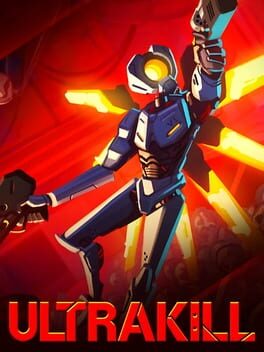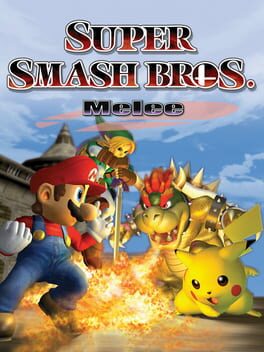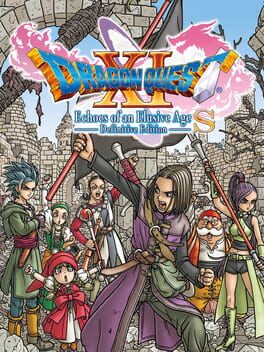wads
4 reviews liked by wads
Ultrakill
2020
This review contains spoilers
Spoilers for both Dragon Quest XI S and Final Fantasy VI below.
I don’t think I’m breaking new ground when I say that Dragon Quest XI S: Echoes of an Elusive Age is a fantastic game. It had already earned its spot as an all time great in the JRPG genre as soon as it was released, after all. I don’t really have much new to add to the conversation in that regard, but I’m willing to join the choir of voices that sing this game’s praise.
The systems of Dragon Quest XI have been filed down to near perfection with a laser beam. It is, of course, standing on the shoulders of giants; Being the result of over thirty years of iteration. I think what’s so great about this though is unlike Dragon Quest’s sister series Final Fantasy, the chassis of the original entry can still be found clear as day in the series’ eleventh. If Square-Enix treats every new Final Fantasy like a recent sports car purchase, then Armor Project is the guy prodding away in his garage, tuning up the hot rod he’s owned since 1986. Not to imply one process is worse as a means of propping up another, of course, it’s just nice to play a modern, AAA JRPG that’s like a greatest hits of every single thing that’s fantastic about the genre.
That’s all well and good, but if Dragon Quest XI S simply had good gameplay, I wouldn’t be doing this. What spurned me to clack away on my keyboard is the story, which is another example of Yuji Horii and his team showing how masterful they are at their craft, by delivering a story as standard as you could possibly imagine, while bending and twisting the tropes in minute, yet exciting ways that kept me thoroughly engaged. One would need to look no further than the opening hour of the game: Which introduces us to our player character, a mute boy from a small town, coming of age and discovering he is the chosen one, AKA the Luminary. I know this story, you know this story, and most importantly of all, Yuji Horii knows we know this story. Which is why the events directly afterwards are so effective. Those events being a wrongful imprisonment from a nearby kingdom, and our hero’s home being razed to the ground for even associating with us. Many of the game’s tropier plot points pan out in a similar format. The player asks “Is this [insert classic JRPG plot here]”? And the game responds with, “Yes, but,” It’s fantastic. The game’s greatest example of this is the rug pull at the World Tree, with the retrieval of the Sword of Light. What should be our heroes shining moment is stolen from them as the villain Mordegon, who up to this point had only been spoken of, reveals himself and snatches the blade from the Luminary’s hands, and in the process destroys the World Tree and sends the world into a malaise of darkness. In mere moments, Mordegon turned the tables and effectively won. I couldn’t help but be reminded of the events of Final Fantasy VI, which is very high praise.
The most interesting narrative elements are found afterwards, in “part two” of the game as fans refer to it as. This section of the game focuses on regrouping and picking up the pieces of the world after the Luminary and his friends failed in the fight against Mordegon. Instead of regurgitating the plot, I’ll simply say everyone’s story in this section is extremely effective. My personal favorites have to be Hendrik’s and Serena’s. The former suffering from a major crisis of faith after realizing he was effectively being lied to for his entire life. And the latter who is trying to find the strength to march on after losing her sister, Veronica. Another one of our party members, who gave her life so that the rest of the group would stand a chance of living to fight another day. This twist especially caught me off guard, and was done extremely well. The rematch with Mordegon as a result is incredibly cathartic. Once the credits had rolled I was satisfied with calling this one of the greatest JRPGs I had ever played.
And then the game continued.
Yes, once again I know I’m not breaking any new ground when I say that I am incredibly conflicted by the decision to include a “part three” to the story. This third part of the game involves the Luminary using time travel to undo all of the damage Mordegon caused at the pivotal moment at the end of part one. The Luminary and the Luminary alone travels back in time to rewrite history, to effectively give everyone a happy ending. Admittedly, it’s pretty satisfying to see the villains on the backfoot and squirm because their plans aren’t working, but that feeling quickly waned for me as the ramifications of this story decision began to sink in. All of those fantastic arcs the characters went through in part two are completely gone in this new, definitive timeline, because they never happened. Of course this means that Veronica is saved, but so are many other characters too, like the Queen of Nautica, Rab’s teacher, and even the mermaid for some reason is inexplicably alive in the timeline, despite her arc having a bittersweet conclusion in my playthrough far before the events where the time travel sends the Luminary back to. All of these characters get their happy endings, but it comes at a significant cost to the narrative feeling much more cheap as a result. The biggest examples being Hendrik and Serena. I loved their arcs in part two, but now they haven’t happened. If I may evoke its name one more time, it’s like if after you beat Final Fantasy VI, there was a lengthy section of the game where Celes could travel back in time and stop Kefka from plunging the world into chaos.
It wouldn’t have been satisfying from a narrative standpoint if all of the characters could’ve gone back and saved Veronica, so maybe that’s why only the Luminary gets to time travel. I suppose that’s meant to be the “cost.” But the cost comes in a meta sense, and feels mostly at my expense as I had found myself getting really attached to these characters. So to effectively see their stories’ satisfying conclusions be erased was really disappointing. I found myself doing the bare minimum in part three because of this. Power leveling when appropriate and defeating the true final boss with few issues. I think what sucks most about this aspect of the game is that it’s not really something that can be ignored or treated as a “what if” scenario. There’s too many loose ends in the main story that get addressed in part three. If I may offer this section of the game some praise: I do find Serenica’s happy ending satisfying, even if I don’t exactly understand the mechanics of the Luminary copying his powers to her form, but I don’t want to get lost in the weeds anymore than I already have. The finale credits roll was effective in earning some, but most definitely not all, of the goodwill towards the story part three had erased from existence, to borrow a concept.
Despite all of this negativity, I need to reiterate that I still think this is a fantastic game, and I’m looking forward to playing more Dragon Quest because of it. Even if I find part three disappointing in many ways, I still don’t regret any of my time spent in Dragon Quest XI S. It’s a game I care about a lot. And maybe if I worked on the game like Armor Project did, I’d have been just as tempted as they were to give these characters the happy ending I felt they deserved, at any cost. It seems to me that the biggest flaw Horii and his team exhibited when crafting this game, or rather, its story, was that they cared too much. I just hope that next time they’ll be able to let the dead stay dead.
I don’t think I’m breaking new ground when I say that Dragon Quest XI S: Echoes of an Elusive Age is a fantastic game. It had already earned its spot as an all time great in the JRPG genre as soon as it was released, after all. I don’t really have much new to add to the conversation in that regard, but I’m willing to join the choir of voices that sing this game’s praise.
The systems of Dragon Quest XI have been filed down to near perfection with a laser beam. It is, of course, standing on the shoulders of giants; Being the result of over thirty years of iteration. I think what’s so great about this though is unlike Dragon Quest’s sister series Final Fantasy, the chassis of the original entry can still be found clear as day in the series’ eleventh. If Square-Enix treats every new Final Fantasy like a recent sports car purchase, then Armor Project is the guy prodding away in his garage, tuning up the hot rod he’s owned since 1986. Not to imply one process is worse as a means of propping up another, of course, it’s just nice to play a modern, AAA JRPG that’s like a greatest hits of every single thing that’s fantastic about the genre.
That’s all well and good, but if Dragon Quest XI S simply had good gameplay, I wouldn’t be doing this. What spurned me to clack away on my keyboard is the story, which is another example of Yuji Horii and his team showing how masterful they are at their craft, by delivering a story as standard as you could possibly imagine, while bending and twisting the tropes in minute, yet exciting ways that kept me thoroughly engaged. One would need to look no further than the opening hour of the game: Which introduces us to our player character, a mute boy from a small town, coming of age and discovering he is the chosen one, AKA the Luminary. I know this story, you know this story, and most importantly of all, Yuji Horii knows we know this story. Which is why the events directly afterwards are so effective. Those events being a wrongful imprisonment from a nearby kingdom, and our hero’s home being razed to the ground for even associating with us. Many of the game’s tropier plot points pan out in a similar format. The player asks “Is this [insert classic JRPG plot here]”? And the game responds with, “Yes, but,” It’s fantastic. The game’s greatest example of this is the rug pull at the World Tree, with the retrieval of the Sword of Light. What should be our heroes shining moment is stolen from them as the villain Mordegon, who up to this point had only been spoken of, reveals himself and snatches the blade from the Luminary’s hands, and in the process destroys the World Tree and sends the world into a malaise of darkness. In mere moments, Mordegon turned the tables and effectively won. I couldn’t help but be reminded of the events of Final Fantasy VI, which is very high praise.
The most interesting narrative elements are found afterwards, in “part two” of the game as fans refer to it as. This section of the game focuses on regrouping and picking up the pieces of the world after the Luminary and his friends failed in the fight against Mordegon. Instead of regurgitating the plot, I’ll simply say everyone’s story in this section is extremely effective. My personal favorites have to be Hendrik’s and Serena’s. The former suffering from a major crisis of faith after realizing he was effectively being lied to for his entire life. And the latter who is trying to find the strength to march on after losing her sister, Veronica. Another one of our party members, who gave her life so that the rest of the group would stand a chance of living to fight another day. This twist especially caught me off guard, and was done extremely well. The rematch with Mordegon as a result is incredibly cathartic. Once the credits had rolled I was satisfied with calling this one of the greatest JRPGs I had ever played.
And then the game continued.
Yes, once again I know I’m not breaking any new ground when I say that I am incredibly conflicted by the decision to include a “part three” to the story. This third part of the game involves the Luminary using time travel to undo all of the damage Mordegon caused at the pivotal moment at the end of part one. The Luminary and the Luminary alone travels back in time to rewrite history, to effectively give everyone a happy ending. Admittedly, it’s pretty satisfying to see the villains on the backfoot and squirm because their plans aren’t working, but that feeling quickly waned for me as the ramifications of this story decision began to sink in. All of those fantastic arcs the characters went through in part two are completely gone in this new, definitive timeline, because they never happened. Of course this means that Veronica is saved, but so are many other characters too, like the Queen of Nautica, Rab’s teacher, and even the mermaid for some reason is inexplicably alive in the timeline, despite her arc having a bittersweet conclusion in my playthrough far before the events where the time travel sends the Luminary back to. All of these characters get their happy endings, but it comes at a significant cost to the narrative feeling much more cheap as a result. The biggest examples being Hendrik and Serena. I loved their arcs in part two, but now they haven’t happened. If I may evoke its name one more time, it’s like if after you beat Final Fantasy VI, there was a lengthy section of the game where Celes could travel back in time and stop Kefka from plunging the world into chaos.
It wouldn’t have been satisfying from a narrative standpoint if all of the characters could’ve gone back and saved Veronica, so maybe that’s why only the Luminary gets to time travel. I suppose that’s meant to be the “cost.” But the cost comes in a meta sense, and feels mostly at my expense as I had found myself getting really attached to these characters. So to effectively see their stories’ satisfying conclusions be erased was really disappointing. I found myself doing the bare minimum in part three because of this. Power leveling when appropriate and defeating the true final boss with few issues. I think what sucks most about this aspect of the game is that it’s not really something that can be ignored or treated as a “what if” scenario. There’s too many loose ends in the main story that get addressed in part three. If I may offer this section of the game some praise: I do find Serenica’s happy ending satisfying, even if I don’t exactly understand the mechanics of the Luminary copying his powers to her form, but I don’t want to get lost in the weeds anymore than I already have. The finale credits roll was effective in earning some, but most definitely not all, of the goodwill towards the story part three had erased from existence, to borrow a concept.
Despite all of this negativity, I need to reiterate that I still think this is a fantastic game, and I’m looking forward to playing more Dragon Quest because of it. Even if I find part three disappointing in many ways, I still don’t regret any of my time spent in Dragon Quest XI S. It’s a game I care about a lot. And maybe if I worked on the game like Armor Project did, I’d have been just as tempted as they were to give these characters the happy ending I felt they deserved, at any cost. It seems to me that the biggest flaw Horii and his team exhibited when crafting this game, or rather, its story, was that they cared too much. I just hope that next time they’ll be able to let the dead stay dead.



